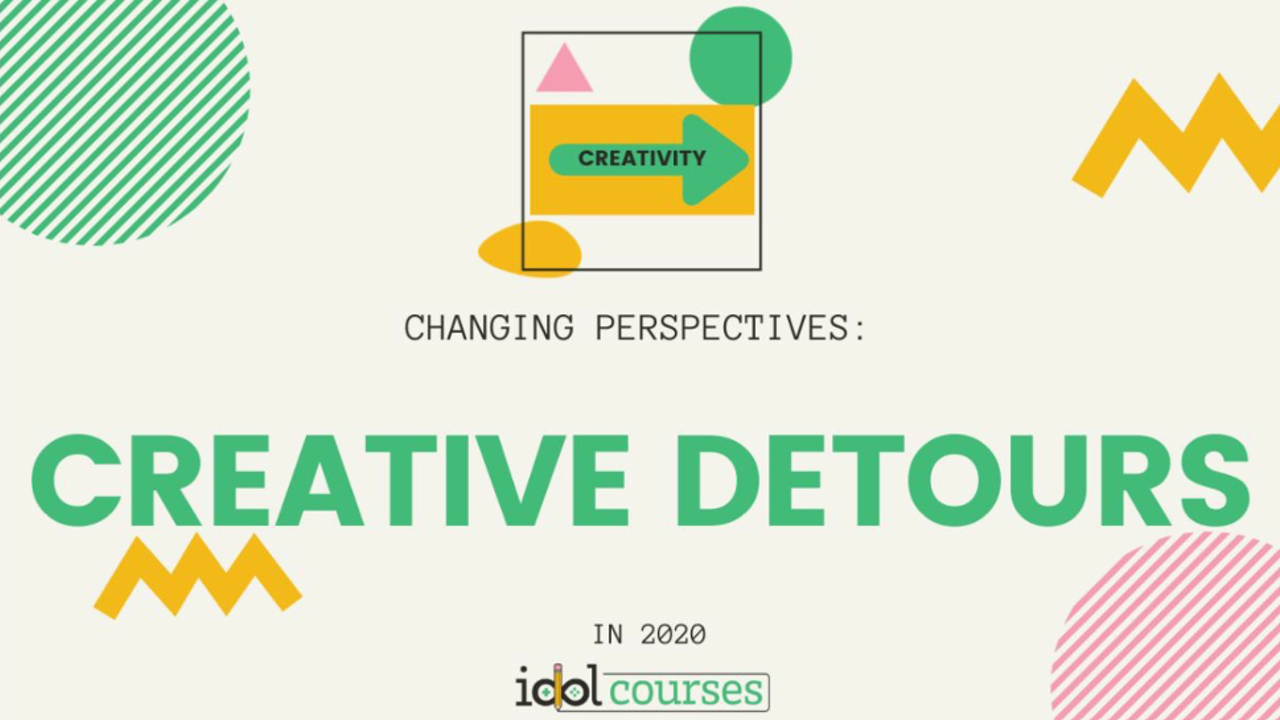Changing Perspectives: Creative Detours
Mar 19, 2020
While I am sure and hope I am not the only one who feels this way, I also know persistence is needed for success. However, I feel that I have hit a roadblock. Initially, I felt roadblocks were negative and something I needed to overcome. Then, I shifted my perspective: Roadblocks force us to detour and lead us down a new path. When finding a solution in the corporate world, these detours lead to innovation. But, where does one find inspiration to navigate a creative detour to success? These 10 tips are what creative writers use when they face writer's block.
- Charles Dickens used to walk for miles every day. He loved to explore. While Google can offer a lot, sometimes a personal exploration through a bookstore or park can yield inspiration.
- Carry a notebook. I always have a sketchbook, 5 pens, and 2 pencils with me. No particular reason- I just seem to accumulate a lot of pens and One habit I developed as a writer is recording observations. As instructional designers, we know observations are important in understanding our learners and thinking about how the systems and processes work.
- Have an objective. Goals are honestly the center of everything I do. As a storyteller and course creator, I depend on goals to give a sense of direction, otherwise, I am a scattered mess, and nothing makes sense to me or anyone else. An important point I learned early on and keep in mind for everything I do is if it does not support the goal or objective, get rid of it. Everything should be done with Deliberate practice falls along with this same concept.
- Research has found that students who outline do far better at writing papers than those who write and edit three or more times. This concept is also true for instructional designers. Having a goal in mind and outlining the steps I need to take to achieve the goal provides for a strong course. It may be a bit redundant, but I outline twice, sometimes three times. The first is to draft the bones, and then I outline for the meat, and finally the third is for the activities to support the goal.
- What would your character do? For instructional designers, the character, or hero, is the learner, and the course is designed to provide a quest for knowledge or skill (or a ring- I am sure that works, too). Either way, thinking about what your character does will help you focus on the learner throughout the course- not you. I say this because we base our bias and assumptions on our own values, and then become confused or annoyed when learners perceive the course or make different decisions than we expected and may be unprepared
- What if. If you have not played the “what if” game. I highly recommend it- especially if you are designing scenario-based It is simply to think of something completely outrageous, but realistic scenario, and present it to your character. What if my learner makes a bad decision? Is it recoverable or game over? What if’s can be used for adding elements to our eLearning as well. So, I challenge you to give it a try on your next project.
- Join a community. Communities are important for eLearning professionals because it provides a home base to learn from and share Through the IDOL Courses Academy, I have connected with many of my peers to brainstorm with and ask for feedback on projects.
- Feedback is critical for improving work. This is a tough one. We have spent hours, days, and weeks on a course or element only to be told that it is not working when we were hoping for “It’s brilliant”. It stings, and sometimes we want to hold on to it and reject all feedback, but rather, what if we used it as a springboard for discussion. Why does it not work? What can be done to improve it? Allowing discourse over a project may inspire new ideas for improvement or even a future project.
- Find your voice (or style). If you look at enough samples, you start to see that the successful IDs have their own unique style that they bring to the eLearning It is what sets them apart. It takes a while to develop your own unique style, but by being aware of it showing up in your projects, it will be easier to identify and hone.
- Practice every day. In the writer's world, it is advised to write every day for at least 20 minutes. I think the same holds true to the eLearning industry. Practicing the authoring tool or the various resources available to enhance a course can build skill, confidence, and By understanding what a tool is capable of allows us to expand our limits. eLearning Heroes Challenges provide inspiration for practice. The challenge with this is to not start tomorrow but rather today.
While these tips are not new or a novel idea, they do serve as a way of inspiring a creative detour.
Written by: Mia Varnadoe

Connect with Mia on LinkedIn.
Slightly quirky with a whole lot of imagination. I love being challenged; It allows me to analyze, brainstorm, and apply interdisciplinary approaches. Furthermore, it provides an opportunity to collaborate with others. My passion is learning because it sets the stage for better performance and well-being. As a learning experience designer, I look at performance challenges and find creative approaches to solve complex and dynamic situations through eLearning and on-the-ground training. Currently open to new opportunities.
Stay connected with news and updates!
Join our mailing list to receive the latest news and updates from our team.
Don't worry, your information will not be shared.
We hate SPAM. We will never sell your information, for any reason.


